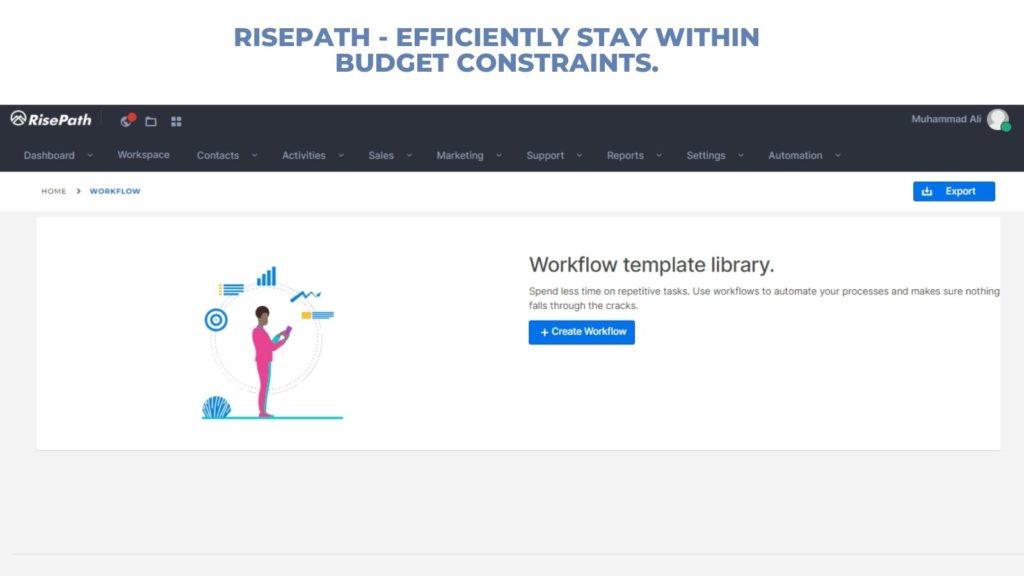Workflow management tools refer to software applications or platforms that enable organizations to streamline and automate their business processes. These tools help in defining, executing, and monitoring various tasks and activities within a workflow, ensuring efficient collaboration and coordination among team members. With features such as task assignment, progress tracking, and notifications, workflow management tools enhance productivity, reduce errors, and improve overall efficiency in an organization’s operations.
The importance of workflow management in organizations cannot be overstated. By implementing a workflow management tool, organizations can eliminate manual and time-consuming processes, resulting in increased productivity and cost savings. Additionally, these tools provide transparency and accountability, allowing managers to track progress and identify bottlenecks in real-time. Ultimately, workflow management tools enable organizations to adapt quickly to changing business requirements and improve their overall competitiveness in the market.

The purpose of this blog is to highlight the significance of workflow management tools in organizations. It aims to demonstrate how these tools can streamline processes, enhance productivity, and save costs.
The blog also emphasizes the importance of transparency and accountability that workflow management tools offer, enabling managers to make informed decisions and identify areas for improvement. Ultimately, the essay seeks to underscore the role of these tools in helping organizations stay agile and competitive in a rapidly evolving business landscape.
Key features of workflow management tools
Automation of business processesinclude task automation, customizable workflows, and integration with other software systems. These tools can automatically assign tasks to the appropriate team members, ensuring that work is distributed evenly and efficiently. Additionally, customizable workflows allow organizations to tailor the tool to their specific processes, making it adaptable to different departments and projects.
Integration with other software systems, such as project management or CRM systems, further enhances efficiency by eliminating the need for manual data entry and enabling real-time collaboration. Overall, these key features make workflow management tools indispensable for organizations looking to optimize their processes and achieve greater operational efficiency.
Task assignment and tracking are also important features of workflow management tools. These tools allow organizations to easily assign tasks to team members, set deadlines, and track progress in real-time. This not only helps to ensure that work is completed on time, but it also provides transparency and accountability within the organization.

With the ability to monitor and track tasks, managers can easily identify bottlenecks or areas where improvements can be made, leading to increased productivity and efficiency. Workflow management tools truly revolutionize the way organizations handle task assignment and tracking, resulting in smoother operations and improved outcomes.
Integration with other software systems is another key advantage of workflow management tools. These tools can seamlessly integrate with project management software, communication platforms, and other business tools, creating a centralized hub for all tasks and information. This integration eliminates the need for manual data entry and ensures that all team members are working with the most up-to-date information.
Also Read: Project Management Software for Your Small Business
Furthermore, the integration allows for easy collaboration and communication among team members, fostering a more efficient and cohesive work environment. Overall, workflow management tools streamline processes and enhance productivity by seamlessly integrating with existing software systems.
Benefits of using workflow management tools
Are low productivity and unsatisfied customers the main issues facing your company? Do your employees have an knowledge of their duties and standard operating procedures? Are you struggling to improve your business’s operating efficiency?
In this case it is imperative to have a strong workflow management system could be beneficial in bringing cutting-edge technology into one platform, allowing businesses gain insights into their business processes and workflows, reduce obstacles, and get greater control. A well-designed and automated system helps in reliable and secure data, affluent communication, increased efficiency, improved collaboration between teams, as well as less waste and mistakes.
Based on Workato Customer Statistic, “94% of business professionals at enterprise organizations say they would rather use a unified platform integrating their applications and building workflow automation than rely on several systems.” Implementing several tools for automation and integration might not only cost more but be a challenge for internal management. Furthermore, it results in the use of time and effort since more employees have to collaborate across the various platforms to achieve the automation or integration.
A complete, powerful and easy-to-use workflow management software allows companies to incorporate automation that is focused on employees and enhance customer experience.
Then, why is it crucial for businesses to have a an effective and integrated system for managing workflow and processes? Read more about it the following article:
How Workforce Analysis Can Transform Your Small Business
Get actionable insights into your business Operations
Mapping out workflows allows companies to get a high-level and more precise overview of their business. Even in established business operations, there may are there bottlenecks which could affect the bottom revenue. Does your process for managing workflow producing outcomes?
The use of a complete and automated system allows you to gain greater insight into your business to identify loopholes, comprehend the potential for improvement and increase profits.
Reduced Errors & Redundancies
It is virtually impossible for companies to run without redundant systems. However, a solid workflow system can help take an active approach to finding and fixing the mistakes earlier. It will assist in identifying the specific part that is in error and requires improvement. This will help you get rid of the issues and prevent similar mistakes from happening again.
Additionally the workflow management system will assist in automating processes and cut down on the amount of repetitive and unnecessary work by delivering actionable information about the business processes.
Improved Transparency and Accountability
Automated systems that are efficient have sophisticated tracking features that enable executives to allocate the tasks and track progress for various projects. A powerful workflow management software will provide further information on any changes made to a procedure and also provide insight on the role of a manager or supervisor.

With the help of workflow automation it is easier to track processes and improve accountability. This allows you to identify gaps, eliminate bottlenecks while also monitoring progress. You can also recognize outstanding performers.
Elevate Customer Experience
Automation and streamlining processes allows businesses to increase productivity of workflows, improve efficiency, and provide top-quality services and products on time. All of these contribute to a better customer experience an essential element in which determines the overall performance of a company.
But, relying on any automated tool to enhance the CX (customer experience) is a complete waste of time for the majority of customers. For instance, using chatbots that don’t seem to comprehend the issue and offer reliable solutions.
However, workflow management program that is enhanced with Artificial Intelligence can assist in simplifying complicated CX operations, and create enjoyable interactions using human-like touchpoints and streamline workflows to provide the best experience for all users.
Effective Service Management
One of the main reasons to have dedicated software for workflow management is to provide better customer service – an essential aspect that all businesses compete with. With a well-organized service management system and a user-labeled interface for customers it is possible to streamline communications for both your customers and clients – on a single platform, where employees are able to help solve a problem at the most efficient time and provide a superior customer service.
Automated workflows that can be customized and personalized allow businesses to streamline their the business process, decreasing costs and time, while ensuring quick access to documents to the appropriate people at the appropriate moment. Any data that is missing or incorrect is instantly detected and relevant users immediately alerted so that the error can be rectified or added to.
Also Read: Why Small business need Project Scheduling Software
The use of a modern system also helps in reducing errors caused by manually entered data. This means you will create more efficient and quicker business processes, which help to cut labor and operational expenses, while also increasing the efficiency of your operations.
According Investopedia, “Improving operations is not a simple task. It’s a multi-faceted effort that involves improving processes, people finance, technology, and people.” In order to achieve this businesses should concentrate on improving workflows, establishing an effective financial plan in conjunction with people and utilizing the latest technology.
Connecting your employees to each other by defining roles clearly and giving them access to the appropriate information at the right moment can improve the efficiency of workflows. Only a well-designed workflow software can keep your employees organised focused, goal-oriented, and cooperative. This helps in creating an improved workplace culture that is where everyone understands the importance of having streamlined and organized processes that help you meet your goals more efficiently.
With a well-designed process management system businesses can put in place data encryption and improve security on all levels. This can assist your company to stay in compliance and avoid costly fines through ensuring accountability and transparency. All data related to processes, technologies and finances, as well as people and customer experience is available in a single location and easily accessible to auditors and ensure compliance.
Better Strategic Planning
A well-designed and automated workflow systems are able to gather data on various people and projects to help improve the efficiency of your organization. This allows you to develop efficient strategies and take informed choices about many aspects of your company. It gives you actionable insight into your company’s strengths and weaknesses to ensure that you are capable of making decisions that improve efficiency, decrease costs and improve your profitability of your business.
Also Read: The Ultimate Guide to Mastering Workflow Management for Peak Productivity
There are always some difficulties you have to encounter when switching to the latest work management program. But, the advantages of using a system like this are substantial for companies regardless of size or industries. It is therefore essential to conduct a thorough study prior to implementing the system and make sure it is able to meet your business needs.
Challenges and considerations in implementing workflow management tools
One of the biggest problems with workflow automation is to ensure the security and quality of the data utilized, processed and stored by automated systems. Insufficient data quality could cause problems, errors, or problems with the results of the workflow. Security of data can be compromised by cyberattacks, unauthorised access or even human error.
To address these issues you must implement data validation cleaning, verification, and validation procedures, along with backup, encryption and recovery tools. Additionally, you should adhere to guidelines for compliance and governance of data and policies, and educate your employees in data protection and the best practices.
Another obstacle to automated workflows is the management of evolution and acceptance of the new procedures and systems by your employees as well as your customers and other stakeholders. Workflow automation may cause resentment and confusion for some who be afraid of losing their job, qualifications or even control. It could also require significant investment, training, as well as assistance to ensure seamless process of integration and transition.
To get over these hurdles it is essential to explain the benefits, objectives and expectations of workflow automation in a clear and frequent manner and include your employees as well as customers and other stakeholders in the creation as well as the testing and feedback on your automated workflows. Also, you must provide the right training, direction and rewards to help your employees adapt and accept the new working methods.

Another challenge with workflow automation is the flexibility and scalability of the automated processes and systems to adapt to the evolving demands and requirements of your company. Automation of workflows can lead to rigidity and complexity or a dependence on existing processes and systems.
This could hinder your ability to adapt to emerging opportunities, issues or needs. To overcome these obstacles it is important to create the automated workflows you use with scale as well as adaptability in mind. You can do this by employing modular, reusable and adaptable logic and components. It is also essential to examine, monitor and improve your automated workflows on a regular basis by using feedback, data analytics, and test tools, to ensure that they’re functioning well and meeting your goals.
Another challenge in workflow automation is managing the technical aspects and maintenance of automated processes and systems. Workflow automation is susceptible to issues, bugs or malfunctions due to problems with software, hardware and network interruptions or human errors. They can result in delays, interruptions or even loss of workflow’s outputs and results.
To combat these issues it is essential to create an effective maintenance and technical support system that clearly defines duties, roles, and ways to troubleshoot, fix technical issues, and preventing them. It is also essential to ensure your automated processes and systems are compatible, interoperable and current with the latest software equipment, hardware, and security standards and capabilities.
Conclusion
The coming alterations in the near future are valid as they are in the scope of workflow. The technology will grow and eventually grows workflow automation. There is a need to work on a deepened understanding of the workflows and streamline them with strong insights into the operations shaping the business plans. This can upgrade the workflows to build a smooth working culture between work from home and the hybrid model. Moreover, workflow management tools can foster teamwork and innovation.
RisePath, a no-code workflow automation platform, offers 10X times faster and more reliable workflow automation tools than other traditional services. Most importantly, these tools are scalable and easy to understand. Begin your journey towards streamlined operations and tailored apps – all with the simplicity of our platform. Get started today to harness the potential of automation.

Comments are closed, but trackbacks and pingbacks are open.